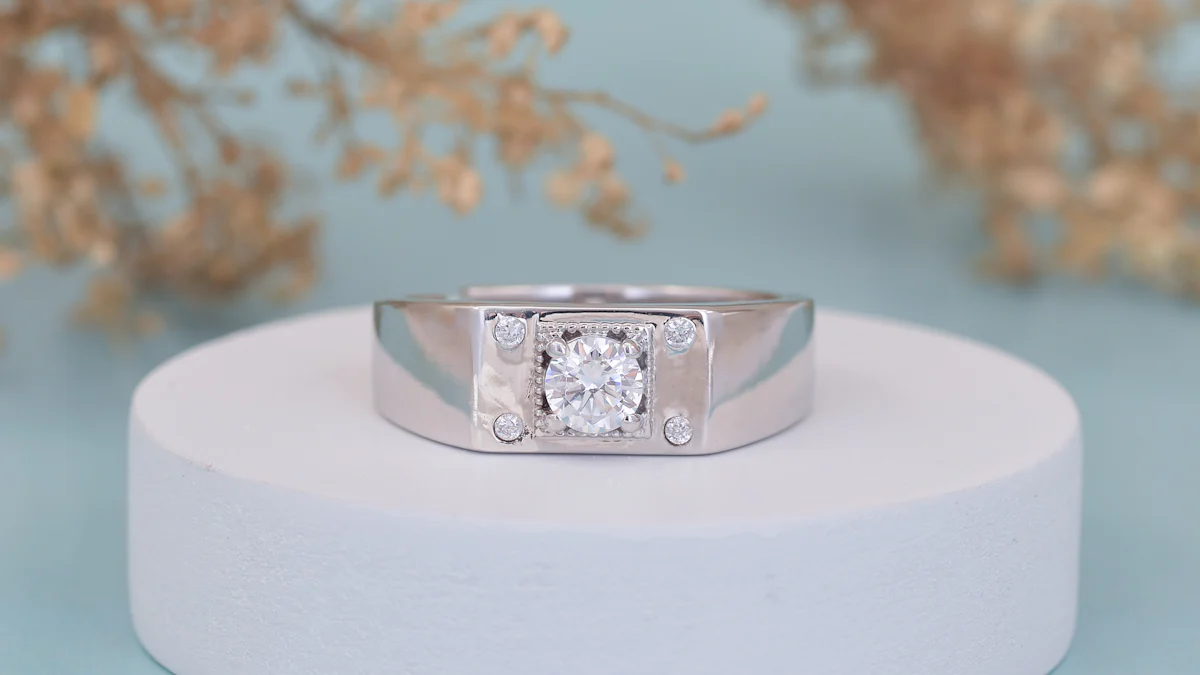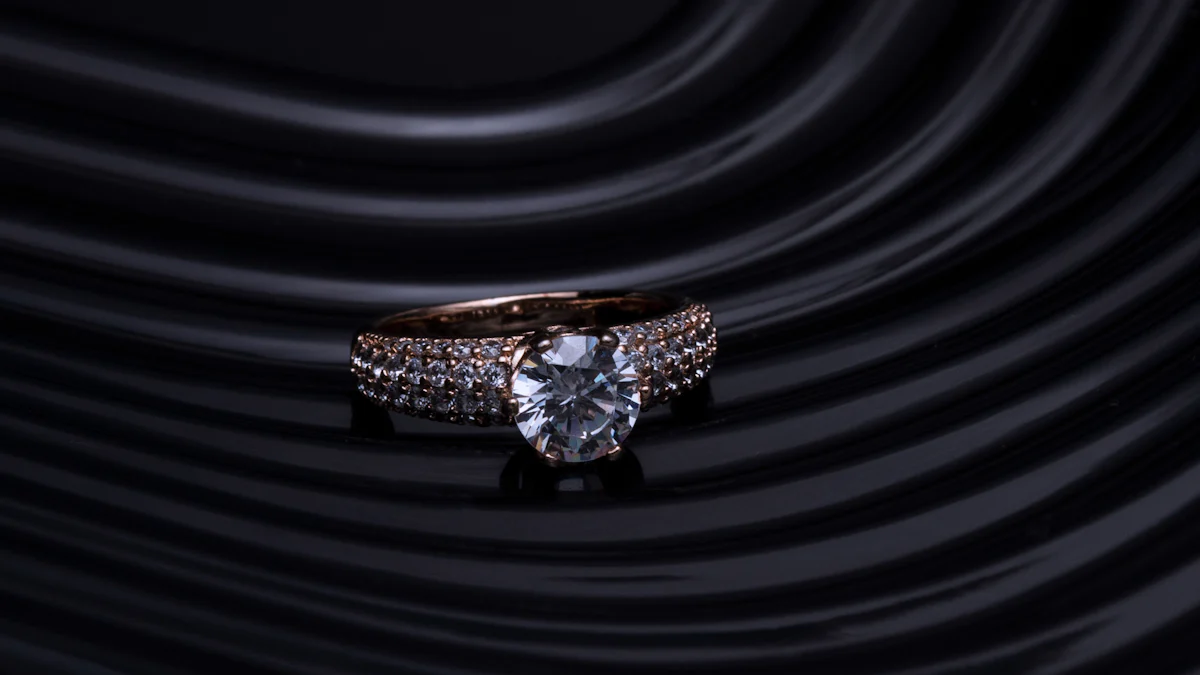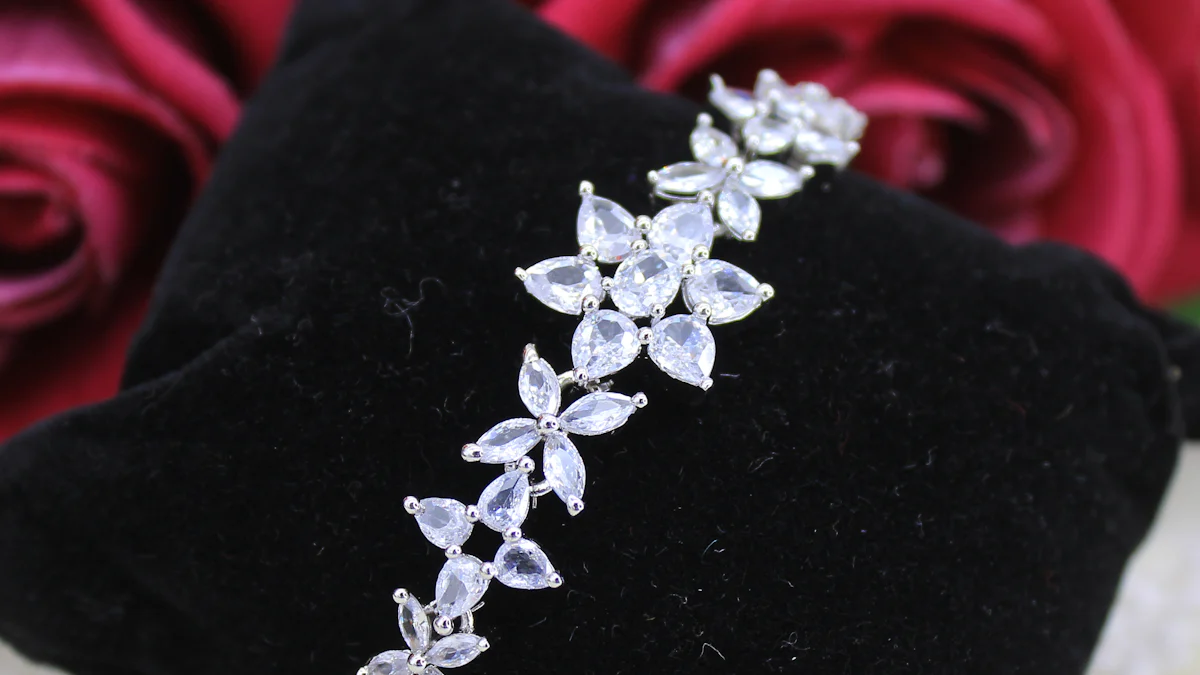TW Meaning Explained in Diamond Jewelry Terms

In diamond jewelry, the "TW meaning" refers to "Total Weight." This term represents the combined weight of all diamonds or gemstones in a single piece of jewelry. For example, if a ring contains multiple diamonds, their weights are added together to calculate the total weight. Understanding this concept is essential because it provides a clear measure of the overall diamond content in a piece. Unlike focusing on a single stone, "TW" gives you a complete picture of the jewelry's value and appearance.
Key Takeaways
- TW stands for 'Total Weight' and represents the combined weight of all diamonds or gemstones in a piece of jewelry, providing a clear measure of its overall value.
- Understanding TW helps you evaluate the visual appeal of jewelry; a higher total weight often indicates more sparkle and presence.
- TW is measured in carats, where the weights of individual stones are added together, allowing you to assess the overall diamond content rather than focusing on a single stone. Don't confuse TW with CT (Carat Weight); TW refers to the total weight of all stones, while CT measures the weight of a single diamond. Quality matters! TW does not reflect the quality of the stones, so consider cut, clarity, and color when evaluating jewelry.
- When shopping, ask questions about TW to clarify whether it includes all stones, the size of the largest stone, and the quality of the diamonds.
- Use TW as a starting point for understanding jewelry value, but always consider the quality and arrangement of the stones for a well-rounded decision.
TW Meaning: What Does "TW" Represent?

Definition of "TW" in Diamond Jewelry
In diamond jewelry, "TW" stands for "Total Weight." This term represents the combined weight of all diamonds or gemstones in a single piece of jewelry. For instance, if you own a diamond ring with a central stone weighing 1 carat and smaller diamonds around the band adding up to another 1 carat, the total weight of the ring equals 2 carats. This measurement provides a comprehensive understanding of the diamond content in your jewelry.
Jewelry pieces like eternity rings often rely on "TW" or "CTTW" (Carat Total Weight) to describe their overall diamond weight. These rings feature numerous small diamonds encircling the band, making "TW" a practical way to convey their value. On the other hand, engagement rings typically highlight a single large diamond, with smaller stones contributing less to the total weight. Understanding this distinction helps you interpret the "TW meaning" more effectively when comparing different types of jewelry.
How "TW" Is Measured in Carats
The weight of diamonds is measured in carats, where one carat equals 200 milligrams. When a jewelry piece contains multiple diamonds, their individual weights are added together to calculate the total weight. For example, a ring with ten diamonds, each weighing 0.10 carats, will have a total weight of 1.00 carat. This cumulative measurement ensures that you can assess the overall diamond content rather than focusing on a single stone.
"TW" becomes especially important when evaluating jewelry with multiple small diamonds. A 1/2 carat total weight diamond piece, for example, can be just as stunning as a larger diamond if the stones are well-cut and of high quality. By understanding how "TW" is calculated, you can make informed decisions about the value and appearance of the jewelry you choose.
Why Is "TW" Important in Diamond Jewelry?
Understanding the Value and Appearance of Jewelry
"TW" plays a crucial role in helping you evaluate the overall value and visual appeal of diamond jewelry. When you look at a piece of jewelry, the total weight of the diamonds or gemstones directly influences its perceived worth. A higher total weight often indicates more gemstone content, which can make the jewelry appear more luxurious and valuable.
For example, if you compare two rings, one with a "TW" of 1 carat and another with a "TW" of 2 carats, the latter will likely have more sparkle and presence due to the additional gemstone weight. This comparison allows you to assess which piece better suits your preferences for size and brilliance. However, remember that "TW" focuses solely on the combined weight of the stones, not their quality or cut. By understanding this distinction, you can make more informed decisions when selecting jewelry that aligns with your style and budget.
Differentiating Between Weight and Quality
While "TW" provides insight into the total gemstone weight, it does not reflect the quality of the stones. Quality factors like cut, clarity, and color significantly impact the beauty and value of diamonds. Two pieces of jewelry with the same "TW" can differ greatly in appearance and price if one features higher-quality stones.
For instance, a bracelet with a "TW" of 1 carat made up of poorly cut diamonds may lack brilliance compared to a similar bracelet with well-cut diamonds of the same weight. This highlights the importance of not relying solely on "TW" when evaluating jewelry. Instead, consider both the weight and the quality of the stones to ensure you get the best value for your investment.
When shopping for diamond jewelry, use "TW" as a starting point to understand the gemstone content. Then, delve deeper into the quality aspects to make a well-rounded decision. This approach ensures that you choose a piece that not only meets your expectations for size but also delivers exceptional beauty and craftsmanship.
Common Misunderstandings About "TW"
Confusion Between "TW" and "CT" (Carat Weight)
Many people confuse "TW" with "CT," but these terms have distinct meanings in diamond jewelry. "TW," or Total Weight, refers to the combined weight of all diamonds or gemstones in a piece of jewelry. On the other hand, "CT," short for Carat, measures the weight of a single diamond or gemstone. This difference is crucial when evaluating jewelry.
For example, a ring with a "TW" of 1 carat may include multiple smaller diamonds that add up to 1 carat in total. However, a ring labeled as having a "CT" of 1 carat typically features a single diamond weighing 1 carat. The visual impact of these two pieces can vary significantly. A single large diamond often appears more prominent than several smaller stones with the same total weight.
Understanding this distinction helps you avoid confusion when shopping for jewelry. Always check whether the label refers to "TW" or "CT" to ensure you know what you're purchasing. This knowledge allows you to make better comparisons between different pieces and choose the one that meets your expectations.
Misleading Assumptions About "TW"
Some buyers assume that a higher "TW" automatically means better quality or greater value. This assumption can lead to disappointment. "TW" only measures the total weight of the stones, not their quality, cut, or clarity. Two pieces with the same "TW" can differ greatly in appearance and price due to differences in these factors.
For instance, a necklace with a "TW" of 2 carats might feature poorly cut diamonds that lack brilliance. In contrast, another necklace with the same "TW" could include well-cut diamonds that sparkle beautifully. The latter piece would likely appear more attractive and carry a higher price tag.
Another common misconception is that "TW" reflects the size of individual stones. A bracelet with a "TW" of 1 carat might consist of many tiny diamonds, while another with the same "TW" could feature fewer but larger stones. The overall look of these pieces would be quite different.
To avoid these pitfalls, focus on more than just the "TW" when evaluating jewelry. Ask about the quality, cut, and size of the stones. This approach ensures you understand the true value and appearance of the piece you're considering.
Tips for Buyers to Understand "TW"

How to Interpret "TW" When Shopping for Jewelry
When shopping for diamond jewelry, understanding "TW" ensures you make informed decisions. "TW," or Total Weight, represents the combined weight of all diamonds or gemstones in a piece. This includes both the center stone and any smaller accent stones. For example, a ring with a "TW" of 1 carat might consist of one large diamond or several smaller ones that add up to 1 carat. Knowing this helps you evaluate the overall gemstone content.
To interpret "TW" effectively, always check the details provided by the jeweler. Look for descriptions that specify whether the weight refers to a single stone or multiple stones combined. If the label only mentions "TW," ask for clarification. This ensures you understand whether the piece features a prominent center stone or a collection of smaller stones. By doing so, you can better assess the jewelry's appearance and value.
Additionally, consider how "TW" influences the design. A higher "TW" often means more sparkle and presence, but it doesn’t guarantee quality. Focus on how the stones are arranged and whether they align with your preferences. For instance, a bracelet with a "TW" of 2 carats might feature many small diamonds, creating a delicate look. In contrast, a necklace with the same "TW" could include fewer but larger stones, offering a bolder style. Understanding these nuances helps you choose jewelry that matches your taste.
Questions to Ask About "TW" to Avoid Misunderstandings
Asking the right questions about "TW" prevents confusion and ensures you get the best value. Here are some key questions to consider when evaluating a piece of jewelry:
-
Does the "TW" include all stones in the piece?
Confirm whether the total weight accounts for every diamond or gemstone, including accent stones. This helps you understand the full scope of the jewelry's design. -
What is the size of the largest stone?
Knowing the size of the largest diamond or gemstone gives you a clearer picture of the piece's focal point. A single large stone often has a different visual impact compared to multiple smaller stones. -
Are the stones of similar quality?
Ask about the cut, clarity, and color of the stones included in the "TW." Variations in quality can affect the overall appearance and value of the jewelry. -
How does "TW" compare to individual carat weight?
Clarify whether the "TW" refers to a single stone or the combined weight of multiple stones. This distinction helps you avoid assumptions about the size and prominence of the diamonds. -
Is there a certificate or documentation for the stones?
Request a certificate that outlines the details of the diamonds or gemstones. This document provides valuable information about the "TW" and ensures transparency.
By asking these questions, you gain a deeper understanding of the "TW meaning" and how it applies to the jewelry you're considering. This knowledge empowers you to make confident purchasing decisions and select pieces that meet your expectations.
Understanding the tw meaning, or "Total Weight," is essential when evaluating diamond jewelry. It represents the combined carat weight of all diamonds or gemstones in a piece, giving you a clear picture of its overall value and appearance. By knowing this, you can make informed purchasing decisions that align with your preferences and budget. However, don't rely solely on total weight. Always consider factors like quality, size, and clarity to ensure the jewelry meets your expectations. This comprehensive approach helps you select pieces that truly reflect your style and investment goals.
FAQ
What does "TW" stand for in diamond jewelry?
"TW" stands for Total Weight. It represents the combined weight of all diamonds or gemstones in a piece of jewelry. For example, if a bracelet contains multiple diamonds, their weights are added together to calculate the total weight.
Why is "TW" important when buying diamond jewelry?
"TW" helps you understand the overall diamond content in a jewelry piece. It provides a clear measurement of the total gemstone weight, which influences the appearance and value of the item. Knowing this ensures you make informed purchasing decisions.
How is "TW" different from "CTW"?
"TW" refers to the total weight of all stones in a jewelry piece, including diamonds and other gemstones. "CTW," or Carat Total Weight, specifically measures the combined weight of all diamonds in the jewelry. This distinction helps you identify whether the weight includes only diamonds or other stones as well.
What is the difference between "TW" and a single diamond's weight?
"TW" represents the combined weight of all diamonds or gemstones in a jewelry piece. A single diamond's weight, however, refers to the carat weight of just one stone. For example, a ring with a "TW" of 1 carat might include several smaller diamonds, while a single diamond weighing 1 carat would appear larger and more prominent.
What does "TDW" mean in jewelry?
"TDW" stands for Total Diamond Weight. It describes the total weight of all diamonds in a jewelry piece. This term is similar to "CTW" but focuses exclusively on diamonds, excluding other gemstones.
How does "TW" affect jewelry valuation?
"TW" plays a significant role in determining the value of a jewelry piece. A higher total weight often indicates more gemstone content, which can increase the item's worth. However, you should also consider the quality of the stones, as weight alone does not guarantee value.
Can "TW" be misleading?
Yes, "TW" can sometimes be misleading if you don't understand what it represents. For instance, a necklace with a "TW" of 2 carats might consist of many small diamonds, while another with the same "TW" could feature fewer but larger stones. Always ask for details about the size, quality, and arrangement of the stones to avoid confusion.
How can you interpret "TW" when shopping for jewelry?
To interpret "TW" effectively, check whether it includes all stones in the piece or just diamonds. Ask about the size of the largest stone and the quality of the gemstones. This information helps you assess the jewelry's overall appearance and value.
What questions should you ask about "TW" before buying?
Here are some key questions to ask:
- Does the "TW" include all stones in the piece?
- What is the size of the largest stone?
- Are the stones of similar quality?
- Is there a certificate or documentation for the stones?
These questions ensure you fully understand the jewelry's composition and value.
How does "TW" influence the design of jewelry?
"TW" impacts the design by determining the total gemstone content. A higher "TW" often results in more sparkle and presence. However, the arrangement of the stones also matters. For example, a bracelet with a "TW" of 1 carat might feature many small diamonds for a delicate look, while a necklace with the same "TW" could include fewer but larger stones for a bold style.
See Also
The Importance of Three Stone Diamond Rings Explained
Comparing Tungsten Diamond Rings and Classic Styles
A Guide to Diamond Cuts for Engagement Rings

